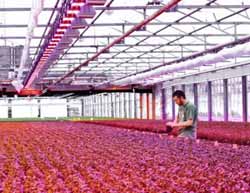Deep-Red LED Light for Greenhouses Save Power

It emits a deep-red light at a wavelength of 660 nanometers, which is perfect for plant photosynthesis. With an efficiency of 37 percent — one of the highest for a light source of this color — it also yields considerable energy savings compared to conventional lamps. In a pilot project in Denmark, which used around 50,000 LEDs to illuminate a cultivation area of several thousand square meters, power consumption in the greenhouse fell by 40 percent.
Relatively little of the light used by plants for their growth is from the visible light spectrum. Chlorophyll molecules mostly absorb deep-red and blue light for the purposes of photosynthesis. Osram Opto Semiconductors has therefore developed an extremely efficient red LED with an emission curve that is very closely matched to the spectral sensitivity of chlorophyll. The new LED is based on the thin-film technology used for high power semiconductor chips.
In greenhouse cultivation, some plants are grown on several levels stacked on top of one another. For this reason, the new LED is available in two variants, each with a different beam angle. The Golden Dragon Plus has a beam angle of 170 degrees and is therefore well suited for use in reflector lamps for illuminating large areas under cultivation. By contrast, the Oslon SSL LED, with a beam angle of 80 degrees, is designed for use in multi-level applications, such as those for the cultivation of lettuce. Using LED light, it is also possible to promote different growth phases of the plant under cultivation. Red light, for example, encourages plants to grow in length, whereas blue light fosters bud formation, for example. Controlled variation of the proportion of blue light between ten and 30 percent reduces use of fertilizer and other chemicals.
Compared to conventional high-pressure sodium lamps, the luminous efficacy of the system as a whole is 60 percent higher with red and blue LEDs. And with a service life of 100,000 hours, the LEDs provide maintenance-free operation for many years. Also involved in the pilot project with Osram were Arrow Electronics and Fiona Lighting A/S, a Danish company specializing in LED lighting for commercial horticulture. Highly efficient LED lighting forms part of the Siemens environmental portfolio, which generated around €28 billion in sales for the company in fiscal year 2010.
Media Contact
More Information:
http://www.siemens.com/innovationnewsAll latest news from the category: Power and Electrical Engineering
This topic covers issues related to energy generation, conversion, transportation and consumption and how the industry is addressing the challenge of energy efficiency in general.
innovations-report provides in-depth and informative reports and articles on subjects ranging from wind energy, fuel cell technology, solar energy, geothermal energy, petroleum, gas, nuclear engineering, alternative energy and energy efficiency to fusion, hydrogen and superconductor technologies.
Newest articles

High-energy-density aqueous battery based on halogen multi-electron transfer
Traditional non-aqueous lithium-ion batteries have a high energy density, but their safety is compromised due to the flammable organic electrolytes they utilize. Aqueous batteries use water as the solvent for…

First-ever combined heart pump and pig kidney transplant
…gives new hope to patient with terminal illness. Surgeons at NYU Langone Health performed the first-ever combined mechanical heart pump and gene-edited pig kidney transplant surgery in a 54-year-old woman…

Biophysics: Testing how well biomarkers work
LMU researchers have developed a method to determine how reliably target proteins can be labeled using super-resolution fluorescence microscopy. Modern microscopy techniques make it possible to examine the inner workings…





















